

WORLD
Brendan Carr’s Bold FCC vs. Trump’s Media Opponents: What You Need to Know! 🚨
Published
1 month agoon
By
OBS
Bernd Debusmann Jr & Natalie Sherman

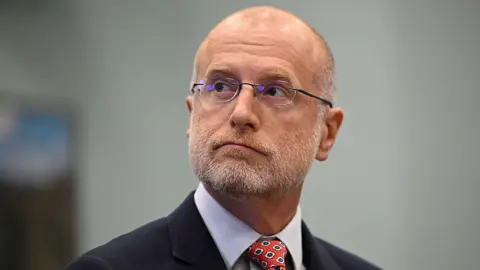 Getty Images
Getty ImagesAfter nearly 23 years on American airwaves, comedian Jimmy Kimmel’s ABC show is on ice.
He was suspended indefinitely by the network after he made comments in the wake of Charlie Kirk’s murder, which mocked the president and appeared to cast blame on his supporters.
A lynchpin in the late-night comedy line-up, Kimmel is the latest media personality to fall foul of the Trump administration in its campaign against perceived liberal bias.
The president has launched personal lawsuits against numerous news outlets and social media companies over treatment he believes is biased against him, and filed a barrage of lawsuits against the Wall Street Journal, New York Times and others.
At his urging, Congress has cut funding for NPR and PBS, while other broadcasters, such as Comcast, have faced threats to have their federal licences pulled – in that case over allegations that their news coverage of the deportation of Kilmar Garcia Abrego to El Salvador was distorted.
In turn, some media companies have agreed to changes in editorial and diversity policies, while others, including ABC and CBS, have paid out multi-million dollar settlements.
Kimmel’s firing has reignited those debates, coming just weeks after Paramount said it was cancelling The Late Show, the highest-rated programme in late night.
It was abruptly discontinued after Stephen Colbert made critical remarks against the president. CBS, which aired it, maintained the decision was purely budgetary.
At the centre of the administration’s fight is Brendan Carr, the 46-year-old chairman of the Federal Communications Commission – the country’s broadcast media watchdog – once hailed by President Donald Trump as a “warrior for free speech”.
The commission regulates radio, TV and satellite airwaves, giving it power over a range of matters, including mergers and decency complaints.
Even before officially assuming his post in January, Carr, a longtime member of the commission, started putting companies on notice that he would be taking an expansive view of his power, with an eye to policing content in unusual ways.
He sent letters to big tech companies, including Apple and Google, demanding information on how they rank news stories and accusing them of participating in a “censorship cartel” – taking on a sector not traditionally within the FCC’s orbit.
It’s an approach that is broadly in line with the White House.
Kimmel’s suspension came after he implied the suspect accused of shooting Charlie Kirk was a conservative, even after Utah officials had said the alleged gunman was “indoctrinated with leftist ideology”.
Carr, in an interview with influential conservative podcaster Benny Johnson, threatened to take action against media companies if they did not push back against Kimmel.
Within hours, Nexstar Media – which has a multi-billion merger pending FCC review – and Sinclair, which collectively own dozens of ABC affiliates across the country, suspended Kimmel’s programme.
Ultimately, ABC said the show would be “pre-empted indefinitely”.

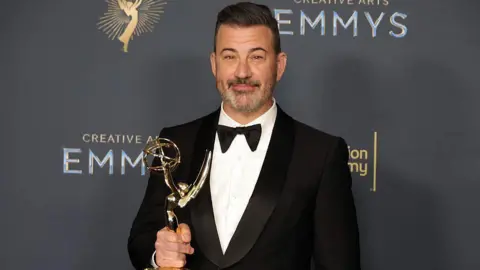 Getty Images
Getty ImagesCarr told CNBC that any change to programming reflected evolving business models, rather than directly as a result of FCC pressure or government censorship.
“It’s not about any particular show or any particular person,” he said. “It’s just that we’re in the midst of a very disruptive moment right now.”
His remarks came as President Trump suggested on Air Force One that most TV networks were opposed to him and should “maybe” have their licences “taken away”.
The controversy has reignited concerns about the pressure the Trump administration is putting on media companies – and whether they are willing to fight back at the expense of their bottom line.
Even some conservatives, including Trump ally Tucker Carlson and Kansas Republican Senator Jerry Moran, have expressed misgivings about whether the administration’s actions could endanger free speech.
In July, Paramount, which owns CBS, sparked outcry with its decision to cancel Colbert.
The move came days before it won FCC approval for a long-sought merger.
As a condition for the merger’s approval, Paramount had committed to ensuring a “diversity of viewpoints” on air and agreed to install an independent reviewer.
Paramount had also previously agreed to a multi-million dollar settlement to resolve lawsuits from Trump, who accused CBS of bias over how it edited an interview with his electoral opponent Kamala Harris.
After the settlement, the network agreed to stop editing such interviews. Disney, which owns ABC, also settled a defamation lawsuit brought by the president.
Experts think the president had little chance of winning either lawsuit in court.
Media companies have proven responsive in the past to pressure from outside activists, said Anthony Nadler, a professor of media and communications at Ursinus College in Philadelphia.
He cited decisions by streamers in 2020 to remove episodes of shows such as Golden Girls and It’s Always Sunny in Philadelphia, with references to black face.
But while Disney might be responding to conservative outcry over Kirk’s death, he said: “Media companies are pre-emptively censoring themselves when people connected with their organisation face criticism from presidential power.”
Analysts said consolidation in the media industry has made it more vulnerable to government pressure, while some decisions might also reflect conservative leanings of owners of media companies, like Sinclair, which runs almost 200 television stations across the US.
Importantly, for many of America’s biggest media companies, news and late-night programming tends to represent a comparatively small part of their overall business, which can extend to movies, amusement parks and internet service.
Still, some outlets are holding firm. The New York Times, which is not regulated by the FCC, has vowed it “will not be deterred by intimidation tactics”.
Jeffrey Sonnenfeld, professor of leadership at Yale and founder of the Chief Executive Leadership Institute, said the Trump administration in its second term was intruding in business affairs in unprecedented ways.
But he said in this case, he thought Disney would have made a similar decision, even without the pressure.
He noted chief executive Bob Iger also cancelled Roseanne Barr’s show in 2018 over an inflammatory tweet and duelled with Florida’s Republican Governor Ron DeSantis.
“If Jimmy Kimmel was being removed for being a Trump critic, Iger would hold his ground, but unfortunately [Kimmel] made it hard to do by mocking murder,” he said. “Making fun of murder is just not part of Disney’s brand.”
You may like
WORLD
Unlocking Opportunities: How Trump’s $100,000 Visa Could Revolutionize Indian and US Industries!
Published
1 month agoon
September 22, 2025By
OBS
Soutik Biswas and Nikhil InamdarDelhi
Panic, confusion and then a hasty White House climbdown – it was a weekend of whiplash for hundreds of thousands of Indians on H-1B visas.
On Friday, US President Donald Trump stunned the tech world by announcing an up to 50-fold hike in the cost of skilled worker permits – to $100,000. Chaos followed: Silicon Valley firms urged staff not to travel outside the country, overseas workers scrambled for flights, and immigration lawyers worked overtime to decode the order.
By Saturday, the White House sought to calm the storm, clarifying that the fee applied only to new applicants and was a one-off. Yet, the long-standing H-1B programme – criticised for undercutting American workers but praised for attracting global talent – still faces an uncertain future.
Even with the tweak, the policy effectively shutters the H-1B pipeline that, for three decades, powered the American dream for millions of Indians and, more importantly, supplied the lifeblood of talent to US industries.
That pipeline reshaped both countries. For India, the H-1B became a vehicle of aspiration: small-town coders turned dollar earners, families vaulted into the middle class, and entire industries – from airlines to real estate – catered to a new class of globe-trotting Indians.
For the US, it meant an infusion of talent that filled labs, classrooms, hospitals and start-ups. Today, Indian-origin executives run Google, Microsoft and IBM, and Indian doctors make up nearly 6% of the US physician workforce.
Indians dominate the H-1B programme, making up more than 70% of the recipients in recent years. (China was the second-largest source, making up about 12% of beneficiaries.)
In tech, their presence is even starker: a Freedom of Information Act request in 2015 showed over 80% of “computer” jobs went to Indian nationals – a share industry insiders say hasn’t shifted much.
The medical sector underlines the stakes. In 2023, more than 8,200 H-1Bs were approved to work in general medicine and surgical hospitals.
India is the largest single source of international medical graduates (who are typically in US on H-1B visas) and make up about 22% of all international doctors. With international doctors forming up to a quarter of US physicians, Indian H-1B holders likely account for around 5-6% of the total.
Experts say pay data shows why Trump’s new $100,000 fee is unworkable. In 2023, the median salary for new H-1B employees was $94,000, compared with $129,000 for those already in the system. Since the fee targets new hires, most won’t even earn enough to cover it, say experts.

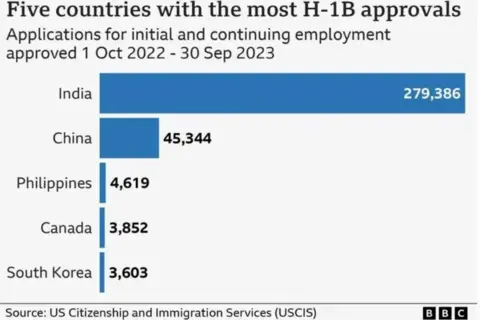
“Since the latest White House directive indicates that the fee would only apply to new H-1B recipients, this is more likely to cause medium and long-term labour shortages instead of immediate disruption,” Gil Guerra, an immigration policy analyst at the Niskanen Center, told the BBC.
India may feel the shock first, but the ripple effects could run deeper in the US. Indian outsourcing giants such as TCS and Infosys have long prepared for this by building local workforces and shifting delivery offshore.
The numbers tell the story: Indians still account for 70% of H-1B recipients, but only three of the top 10 H-1B employers had ties to India in 2023, down from six in 2016, according to Pew Research.
To be sure, India’s $283bn IT sector faces a reckoning with its reliance on shuttling skilled workers to the US, which accounts for over half its revenue.
IT industry body Nasscom believes the visa fee hike could “disrupt business continuity for certain onshore projects”. Clients are likely to push for repricing or delay projects until legal uncertainties are cleared, while companies may rethink staffing models – shifting work offshore, reducing onshore roles and becoming far more selective in sponsorship decisions.
Indian firms are also likely to pass on the increased visa costs to US clients, says Aditya Narayan Mishra of CIEL HR, a leading staffing firm.
“With employers reluctant to commit to the heavy cost of sponsorship, we could see greater reliance on remote contracting, offshore delivery and gig workers.”
The broader impact on the US could be severe: hospitals facing doctor shortages, universities struggling to attract STEM students, and start-ups without the lobbying muscle of Google or Amazon are likely to be hit hardest.
“It [visa fee hike] will force US companies to radically change their hiring policies and offshore a significant amount of their work. It will also ban founders and CEOs coming to manage US-based businesses. It will deal a devastating blow to US innovation and competitiveness,” David Bier, director of immigration studies at the Cato Institute, told BBC.

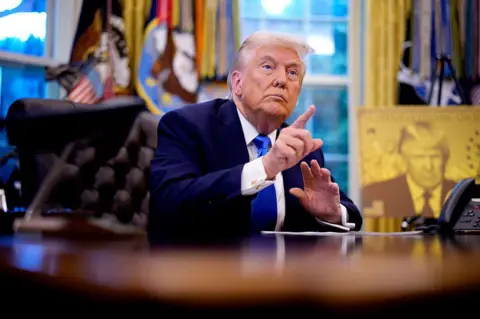 Getty Images
Getty ImagesThat anxiety is echoed by other experts. “The demand for new workers in fields like tech and medicine [in US] is projected to increase (albeit in uneven ways), and given how specialised and critical these fields are, a shortage that lasts even a few years could have a serious impact on the US economy and national well-being,” says Mr Guerra.
“It will likely also incentivise more skilled Indian workers to look at other countries for international study and have a cascading effect on the American university system as well.”
The impact, in fact, will be felt most sharply by Indian students, who make up one in four international students in the US.
Sudhanshu Kaushik, founder of the North American Association of Indian Students, which represents 25,000 members across 120 universities, says the timing – just after September enrolments – has left many new arrivals stunned.
“It felt like a direct attack, because the fees are already paid, so there’s a big sunk cost of anywhere between $50,000 and $100,000 per student – and the most lucrative route to entering the American workforce has now been obliterated,” Mr Kaushik told the BBC.
He predicts the ruling will hit US university intake next year, as most Indian students opt for countries where they can “put down permanent roots”.
For now, the full impact of the tax hike remains uncertain.
Immigration lawyers expect Trump’s move to face legal challenges soon. Mr Guerra warns that the fallout could be uneven: “I expect the new H-1B policy will bring a number of negative consequences for the US, though it will take some time to see what those may be.”
“For example, given that the executive order allows for certain companies to be excepted, it could be possible that some heavy H-1B users such as Amazon, Apple, Google, and Meta will find a way to be exempted from the H-1B fee policy. If they all get exemptions, however, this would largely defeat the purpose of the fee.”
As the dust settles, the H-1B shake-up looks less like a tax on foreign workers and more like a stress test for US companies – and the economy. H-1B visa holders and their families contribute roughly $86bn annually to the US economy, including $24bn in federal payroll taxes and $11bn in state and local taxes.
How companies respond will determine whether the US continues to lead in innovation and talent – or cedes ground to more welcoming economies.

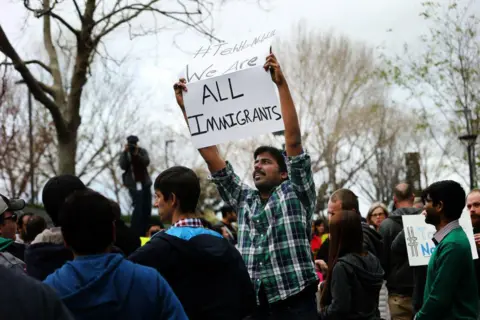 San Francisco Chronicle via Getty Images
San Francisco Chronicle via Getty ImagesWORLD
Apple Intensifies Clash with European Regulators: What You Need to Know!
Published
1 month agoon
September 22, 2025By
OBS
“Bureaucrats in Brussels” are unfairly challenging Apple’s closed ecosystem and denying users the “magical, innovative experience” that makes the firm unique, Apple said.
“We have a serious threat to that in Europe,” executive Greg Joswiak said in advance of the recent launch of its newest products and features.
The so-called walled garden that combines Apple’s products and software ensures a safe and high quality experience for users, it says, but EU regulators counter that it unfairly shuts out rivals.
The two sides have had years of rows, culminating in a €500m (£430m; $586m) fine handed down in April by the EU, which accuses the tech giant of anti-competitive behaviour on its App Store.
As part of the Digital Markets Act (DMA), which came into force in 2022 and began to apply in 2024, the EU targets several major tech companies.
In Apple’s case, the DMA requires it in part to ensure that devices, such as headphones, made by other brands will work with iPhones.
The DMA also requires that Apple allow notifications to show up on third-party smartwatches and not just the Apple Watch – and to let other platforms send and accept content to and from an Apple device via AirDrop.
“That’s a good thing for consumers, because that means that you actually have choice over which device you’re going to use, and you can get them to talk to one another, essentially,” said Sébastien Pant of BEUC, an umbrella group of dozens of consumer advocacy organisations.
“It’s important to try to tackle the kind of walled garden problem that we’ve had for years” and “try to provide consumers with more choice in the digital market,” Pant added.
But Apple is publicly pushing back as it releases its new AirPods Pro 3.
The wireless earphones will feature “Live Translation,” which allows users to hear in their preferred language on their AirPods.
The new AirPods Pro 3 and Live Translation were released last week in the US, but won’t be available to users in Europe for now, Apple said.
The company said the technology is currently only possible by having microphones on AirPods and the iPhone work together, and that opening up access to other devices would require extra engineering work in order to meet user expectations on privacy, security and integrity.
“They want to take the magic away – of having a tightly integrated experience that Apple provides – and make us like the other guys,” Joswiak said during a press briefing with reporters at its headquarters in Cupertino, California.
Apple has mostly refrained from airing its dirty laundry in public – at the request of the regulator, it said.
But it’s getting increasingly vocal as it argues that EU-style rules are bad for users and developers.
The European Commission, the EU’s executive body, on Friday published a decision rejecting Apple’s bid to have the body scrap most of its order requiring Apple to make its iPhone work with other devices.
Last month, the company issued a statement warning the UK’s competition watchdog against following the EU’s lead as the Competition and Markets Authority (CMA) moves ahead with plans aimed at opening up markets dominated by Apple and Google.
European regulators are “creating a worse experience for their citizens – our users,” Joswiak said. “They’re undermining innovation, they’re infringing our intellectual property and they’re damaging privacy and security.”
The BBC reached out to the European Commission for a response.
Apple previously delayed the rollout of its AI-focussed Apple Intelligence features in the EU.
Other companies have also withheld features in the EU because of the DMA, Pant said.
That includes Instagram and WhatsApp’s parent company Meta, which delayed rolling out its social media app Threads in the EU for several months to comply with EU regulations concerning tech firms’ gathering of user data.
WORLD
Outdoor Brand Issues Apology After ‘Dragon’ Fireworks Cause Controversy in the Himalayas – Find Out Why!
Published
1 month agoon
September 22, 2025By
OBS
Osmond ChiaBusiness reporter

 Via Global Times
Via Global TimesChinese officials are investigating outdoor clothing brand Arc’teryx after it apologised for a fireworks display in the Himalayan region of Tibet, which drew backlash for its potential impact on the fragile ecosystem.
Videos from the 19 September event show multi-coloured fireworks erupting across foothills in a display intended to resemble a dragon, designed by Chinese artist Cai Guo-Qiang.
But the promotional campaign sparked a barrage of criticism online, with people saying the stunt contradicts Arc’teryx’s image as a conservation-focused brand and calling for a boycott of its clothing line.
The Canadian firm apologised for the display, saying it was “out of line with Arc’teryx’s values”.

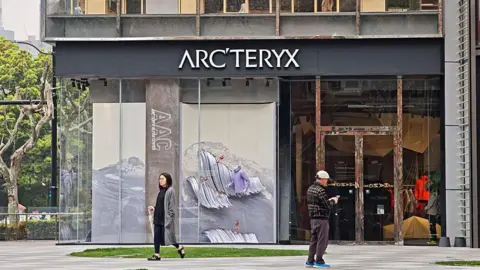 Getty Images
Getty ImagesThe firm said that it will work with an external agency to assess the project’s impact, adding that it had used entirely biodegradable materials. Arc’teryx also said that the spectacle was aimed at raising awareness of mountain culture.
Founded in 1989, Arc’teryx is hugely popular for its high-end sportswear and mountaineering gear and runs more than 150 shops globally. It is owned by Hong Kong-listed fitness equipment company Anta Sports.
It partnered with pyrotechnics artist Cai to stage the high-altitude day-time display called Rising Dragon, set at over 5,000 meters in Tibet’s Shigatse region, a gateway to Himalayan peaks like Everest.
The mountains are also sacred to people in Tibet, where many follow Buddhism. It has been a tightly-controlled part of China since it was annexed in the 1950s, leading some online to ask how and why the project was approved in the first place.
Critics said the mountains were too fragile for fireworks, and the explosions, colour and smoke would have disrupted the ecosystem and local wildlife.

 Getty Images
Getty ImagesA top comment on Arc’teryx’s apology post said the display was “not something that can be forgiven with a single apology post”, and urged the company to take responsibility for any long-term environmental impact.
Another commenter questioned how a project of such scale could have been approved by so many people.
“The public’s criticism has alerted us that the evaluation of the expression of art needs to be more professional and we need to be more humble and respectful of nature,” Arc’teryx said in its statement.
Mr Cai, the artist who has also been criticised, has apologised for his role and said he would work with authorities to help in the area’s recovery.
The 67-year-old artist made his name with gunpowder paintings and outdoor pyrotechnic displays. He famously oversaw fireworks for the 2008 Beijing Olympics.
Categories
Top Tags
Related posts






















